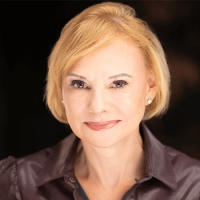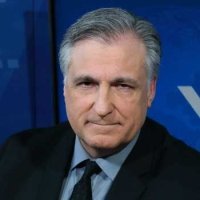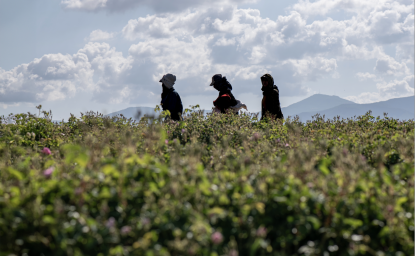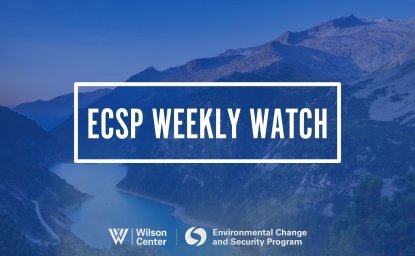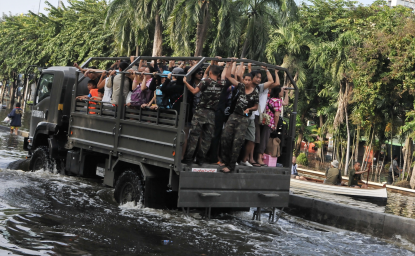THIS IS AN UNEDITED TRANSCRIPT
Hello, I'm John Milewski, and this is Wilson Center
NOW, a production of the Woodrow Wilson International Center for Scholars. I guess they a Sherri Goodman. Sherri has been a leader in an environmental, energy and climate security since she served at the Pentagon as the first deputy undersecretary of defense for environmental Security. Today, she is Secretary-General of the International Military Council on Climate and Security and is also a senior fellow at the Woodrow Wilson International Center for Scholars.
Sherri is often referred to as the mother of climate security, and her new book uses as a title a phrase she used to reshape the discussion of the nexus between climate change and national security threat multiplier. Here's the book Threat Multiplier. The subtitle Climate Military Leadership and the Flight Fight for Global Security. Sherri, welcome and thanks for joining us.
Terrific piece of work. Thank you so much, John. It's a pleasure to be with you again. So reading the book and knowing you firsthand as a colleague at the center, I know that you've been writing this book in your head for decades. Why did you decide to actually write the book at this moment in time? Well, thank you, John.
I wrote the book because I wanted to tell the story of the evolution of environmental and climate security seen through the lens of our war fighters and the other national security professionals that I have spent my life working with and a community I consider myself part of, which includes many unsung heroes whose work to improve our security, our national security and our environment and climate security is it often told and I wanted to leave a legacy also for the next generation.
So let's talk about the term threat multiplier. And it's really interesting because in in the book you tell the story and you have a vivid recollection of sort of your moment where you needed some way to talk about it. And this term popped into your head, sort of a play on a typical usage within the military of force multiplier.
This was in a meeting back in 2007, correct? That's right. In early 2007, after I'd spent a year with the nation's leading recently retired generals and admirals studying climate change and assessing its national security impacts, we drafted our first report, which we were getting ready to release, and we wanted to find a good way to communicate the impacts of climate change on national security.
And we wanted a term that would resonate both within the national security and defense community, but also have broader reach. And that's how the threat multiplier came to be. And and it stuck and it's characterized the whole community and the work of climate and the connection between climate and national security. Now, when I when a lot of lay people talk about climate change, they're often talking about it within the political context of whether you believe it's real or a hoax or all the stuff that goes on.
But the military doesn't have the luxury of dealing in politics, right? They have to look at the reality that they're facing, whether it be in anticipating a mission or training for a mission. And someone one of your reviewers, I think, or maybe perhaps you someone in the book I wrote down the quote, Climate change and global security are intertwined.
You can't tear them apart. So beyond that political realm, where people talk about it in a somewhat whimsical way in terms of national security, what does that actually mean, intertwined? How are these two concepts joined at the hip? Well, you know, as our Earth system changes from rising temperatures and sea level rise and collapsing and thawing permafrost and changing ocean conditions and fires and floods and extreme weather events, that changes the operating environment for our military.
It opens up new sea lanes around the world. As in the Arctic, it prolonged drought leads to is a catalyst for conflict in fragile regions of the world. And we have populations on the move, partly because of growing food and water insecurity. So though that security is very much fundamental, our destabilized earth system today from climate destabilizes, our security security is all about stability, right?
And we no longer have stability in our natural systems because of a disrupted climate. And so that adds that's the threat multiplier to all the other threats we face from China, from Russia, from Iran, from North Korea, nuclear weapons, weapons of mass destruction, terrorism, authoritarian governments, cyber and other risks. All these now come compound. So we have a situation of cop out and cascading risks that we face in any future fight.
And you say stability. Would you add predictability to that equation as well? That you need to be able to anticipate accurately? Yes, of course. We always you know, any military operation is premised on the weather. You know, and think of think of D-Day. You know, Eisenhower made that masterful landing because he made a judgment, relying on his meteorologists about what when the optimal weather conditions would be for that landing.
And today, the weather is less predictable because of the changing climate. And so that adds to the insecurity that we and instability we face. So the story you tell is about you as a young woman entering this world that was a male dominated world back first through the Senate and then moving on to the DOD and elsewhere. And so you've had a ringside seat to see this evolution where it wasn't really talked about in defense circles to now where it's a central part of planning.
Give us the timeline, if you could, with, you know, with the highlights of where you saw these points, where things began to change from where you entered the fray to where things stand today. Well, thank you, John. You know, early in my career, I say it went from weapons to waste as the Cold War ended. You know, I started out as a nuclear weapons analyst and professional staff member on the Senate Armed Services Committee, overseeing the production of nuclear weapons research and development.
And during my time on the Armed Services Committee working for chairman Senator Nunn, the Nuclear Weapons facilities in this country shut down for environment, safety and health lapses. And we went from, you know, for producing weapons to overseeing clean up and environmental management it. I then, you know, continue that work. When I joined the Pentagon in 1993 as the first deputy undersecretary of defense for environmental Security.
And in that era, we were cleaning up military bases, active and closing bases. And in the first year of really learning about complying with major environmental laws, everything from air and water laws, but also protecting endangered species and natural resources and in the early days, that was there was seemingly conflict. I mean, the training ranges at Fort Bragg were shut down for failure to protect the endangered red cockatoo woodpecker, which lives in the longleaf pine tree that populates leaves for Fort now Fort Liberty and many other military bases in the Southeast.
But through understanding what the needs both of the
natural resource the bird was, but also understanding that you could make trade more realistic by using it as an obstacle. We managed to thread that needle. And so we could think about how you could do both. So we started either or you could have environmental protection and you could have strong military training and readiness for our forces.
And that's what we've increasingly found as we moved into the climate era, first thinking that reducing emissions would compromise potentially our ability to have a fighting force, but that now today learning that actually a diversified energy system provides more agility and lighter forces and allows us to operate better in what we call a contested logistics environment of the future so that we've learned that we can have mission readiness.
Climate readiness is mission readiness. And that's that's that's been a revolutionary change. It's evolved. But when you think about it in in a perspective, it's allowed us to both protect our security and protect our people. So now the U.S. military has gone from not thinking of this or just as an afterthought to now what you refer to as a leader.
Well, they're walking the walk, a leader in clean energy and climate. That's really a fascinating evolution. Yes, it is. And it's because there is good alignment today between, as I said, mission readiness and climate readiness and energy resilience so that our military is moving towards net zero energy use. We have net zero military bases already in Georgia and other parts of the US.
Waste to energy plants, micro-grids small nuclear reactors, hydrogen, a variety of a few better batteries, long term energy storage, their variety of a new and new weapons systems designed that are more efficient, energy efficient, so that you can have a still a lethal and ready fighting force. But you can do so in a way that provides more military effectiveness and protects the climate.
You know, I think the best books about policy, in my humble opinion, are those that weave a story, a narrative, right, Because humans react to stories and your and your book does a great job of doing that. You segue from your personal story to the story of how things are happening now. And really that part of the book where you really crisscross the globe and look at the various hotspots and things that are happening.
It was almost like a James Bond movie, right, where we jump from exotic locales to exotic locales. I want to ask you about tying some of what's happening in various parts of the globe to the implications in this for planning at the Pentagon. So, for example, we know that you cover in the book things like bases, both their location and their design training, peacekeeping, anticipation of peacekeeping missions, Wargaming, which is always a fascinating thing from the outside looking at all these things go on and on and have for all time.
But now they're incorporating these climate considerations into that equation and in that James Bond and part of the book, right, where you crisscross the globe, you talk about melting ice in the Arctic or drought and oil in the Middle East or various things that are happening in Latin America, whether it's deforestation. Can you make some connections between those things that are happening on the ground in these various environments?
And then what the direct response is from the Pentagon as it relates to how it's affecting their planning and preparation? Well, sure. Let's let's start with with the Arctic. And I tell the story of Admiral James Foggo, who as a young submariner went up to the Arctic on a submarine and in a maneuver they call ice pick where they surface.
And the submarine does get to pop up and get onto the ice. And they like to play a little baseball and be put on a Santa suit and take some pictures to send back home to their family and friends. Well, fast forward about 20 years later. Now he's in command of the submarine, goes back up to the Arctic and is unable to find enough ice for which to surface.
And when he does actually surface, it's blue water and he sees plastic waste. So that's a changing Arctic. And what that means with an increasingly open ocean in the Arctic is that Russia, for example, sees it as a toll road for transportation from ports in Europe to ports in Asia. And China eyes an increasingly open Arctic as a shorter shipping route, access to minerals and energy resources and in the future fish.
So what does it mean for our forces? We have to be able to protect and defend along our northern coast in ways in our Arctic coast, in ways that we previously didn't have to consider. We have to be able to operate at the surface with ships. Of course, we've long had submarines and we've had aircraft and missiles, but we have to not only operate under sea and in space, but on the surface in the Arctic today, even though it's dangerous still to operate in that region.
And what we see in other parts of the world, in the Indo-Pacific, I call it sort of disaster alley, because the terrifying typhoons that are faced and the stronger storms that have recently damaged, for example, Guam, where we have major military bases, suffered mightily in Typhoon Ma just not long ago. And another strong storm just came through Vietnam in the Philippines.
And so our forces are increasingly called in to respond to humanitarian assistance and natural disasters and provide relief and rescue. And by the way, that's not happening only overseas, but our forces, active duty and National Guard are both also responding with increasing frequency here at home because wildfires now are year round. And so our National Guard is supporting today in California and elsewhere in the US.
Our our our our very dedicated firefighters who are on the front lines and they're responding to floods and hurricanes. For example. Already in Louisiana today, we have another hurricane coming through a federal emergency and the National Guard's been called up. So these are now regular responsibilities of our forces. When Sherri, when you look at you know, we're talking as we sit here, a hurricane approaching Louisiana, a wildfires burning in the U.S. and Canada.
A lot of climate scientists have talked about how some of these worst case scenarios in some cases appear to be happening more quickly than the predictions. So what kind of what can you tell us about the gap between how quickly we're needing to deal with some of these scenarios and how the Defense Department, the National Guard and others are planning?
What is the gap between those two things? Are we anywhere close to where we need to be to deal with the level of threat multiplier that we're actually living through? Well, you're right, John, that the climate risks are accelerating faster than most of society can adapt to that. And and that's true in every sector of society. What the defense Department, what the military is, is doing is trying to close that gap between between reliable weather prediction and short term climate prediction so that we can have better knowledge for planning purposes of, for example, when we're going to need to deploy what that war game situation might look like.
How do we make our ports, our our naval bases resilient to the increasing flooding, for example, at Norfolk Naval Base, now major military base largest in the world. It's already experienced substantial sea level rise, coastal erosion, sunny day flooding sometimes for people in the local community, can't get to work on the base because it's flooded in town on sunny days.
And we see that in other parts of the country now as well. So trying to better be able to protect that close, that close that weather to climate gap in this in timeframes appropriate for defense decision making and other sectors of the economy, transportation, agriculture, insurance. Every sector needs this. Now, that's only about being able to sort of adapt it, become resilient in the long run.
We will also in the short to medium run still, we still need to reduce our greenhouse gas emissions. That's by changing our energy systems. Jerry Anyone who's followed your work or career knows that you're not a hand wringer. You're a doer. But I wonder, do you allow yourself to think in terms of optimism or pessimism as you look at the scope of the challenges?
Well, you know, I love that the phrase by Madeline Albright, who says I'm an optimist, who worries a lot, you know, that that suits me as a as as a mom, as a working mom to I'm optimistic. I hope for my children and my future grandchildren, A, you know, a bright and better future. And, you know, I've had the privilege being the daughter of Holocaust refugees, of living a full life as an American, knowing that the past could have swallowed up any 12 parts of my family.
And so seeing a better future and the American dream. So I believe in that promise of America, and I believe in our innovation and our resilience as a society. So that's what gives me hope. I do believe I do think we have to accelerate into the future on every front, whether it's in this improving predictive capability, whether it's becoming more resilient to climate impacts.
Today, also our energy future. And then finally, it's in reimagining how we work with allies and partners and communities around the world so that we factoring climate security into all of our fundamental relationships. I ask you about that last point. First, is that level of cooperation now internationally operating at a high level? I think it's really accelerated in the last couple
couple of years as we've seen it become mainstream.
Part of all our foreign policy and national security planning, particularly in the Indo-Pacific region, where our allies and partners from, you know, our major allies like Japan, South Korea, Australia, New Zealand, they're feeling those role well effects. But also small island Pacific nations like Tuvalu and Kiribati are losing in the near future parts of their atolls to sea level rise and loss of fresh water and they need to climb.
It's on the front line for them. It's an existential risk and if we want those important, strategically important small island nations to remain American allies and partners, we have to be sensitive to what their needs are. Otherwise, China is right there with an offer of a new port or a new road which might leave them in a debt trap but might meet their urgent or immediate need.
So and then the menu of things that we have to consider that you talked about. I know there was a time where the focus was on prevention, Right. Preventing these things from happening. And now that many of them are already happening, that, you know, that train has left the station. How do you prioritize whether you're talking about awareness or adaptation action or mitigation or resilience?
I know you can't just do one. You have to do all but sort of where are we as a as a species when it comes to tackling this challenge? Are we past the point of major prevention and are now we talking about building more resilient structures, systems, everything necessary to live in a world with a different kind of climate?
Well, yes. I mean, the phrase it captured is we have to walk and chew gum. We have to be able to do, you know, have to become resilient to the climate impacts that are already upon us because storms are stronger, floods are higher, seas have already risen and we still, at the same time have to transform our energy systems so that we reduce our greenhouse gas emissions in the future.
So you have played a major role in in directing how we think about these things and then consequently how we respond to those. And if anyone doubts that they could just read all of the reviews of your book, where that is fairly obvious from some high ranking people from around the world. So with all of that in mind, what are your hopes for the book?
What are the sort of the next steps in how we push this conversation and we get from places we are to places we need to be? Well, thank you, John. I hope the book changes conversations around the world on how we think about climate and national security and not just changes conversations, but changes action. I say that, you know, my career has been about being a change agent from within institutions and big institutions like the Department of Defense or working on the Senate Armed Services Committee or working at think tanks like the Wilson Center where, you know, ideas have power, policies have purpose and can lead to better lives.
But it doesn't always happen overnight. You have to stay with it. You have to continue to work at that change. And that's what I do both. You know, in my current work with the International Military Council on Climate and Security, building a strong community of practice around the world with military and national security leaders in in dozens of countries who are also committed to this and committed to doing this in a way that benefits societies and can withstand changes in electoral politics.
Sherri, I'm going to perhaps embarrass your secretary. I want to read from one of these reviews. Right. Because this really struck me in terms of, you know, working in the world of ideas, as you now do. And we do at the Wilson Center. You know, they're on your best days. You're feeling like perhaps you're having an impact, right, That people are gaining some value from the ideas that you're sharing and acting on those on your worst days.
You might feel like you're tilting at windmills right where the problems are so large. But I think this was a really interesting this was the review from The Washington Post, and I think they summed up not just the arc of your career, but also kind of the way these things work and the way change occurs. And, you know, portion of what I'll read this portion of the review, it says, what is distinctive, even special about.
GOODMAN This book is her description of how she moved from academia to Senate staff work to a senior Pentagon position to a perch in the think tank universe that is a successful career, even a highly successful one. But it's also the sort of trajectory that rarely gets documented. Goodman Perspective is valuable. It's a reminder that progress can be made.
However, how, however, how slowly it may go, and more significantly, it's a reminder that progress mostly has less to do with sudden revolutionary change than with the steady work of repeating oneself in nice conference rooms in the hopes of catching the ear of people who can change policy ever so slightly. I thought that was really an eloquent and brilliant summary, not only of your work, but of how these things work.
Yes, it's a yes. It speaks to the merit and value of of public service, which I have long been a champion of and which often isn't sufficiently many. So many public servants. Their work is art goes unheralded and and so I think that that steady drumbeat and sticking to, you know, sticking to the work and working in partnership with people across many decades and in many different ways that has I very much appreciate that that recognition.
But also I realize that there are many who have done this and that's it. That's important. And that amounts to two important change that. Thanks for being humble and also thanks for remembering those people who you list in the book. Plenty of names that you recognized for being part of this work over there. Sherri, congratulations on the book.
Thanks for joining us today. I look forward to a future conversation. Thank you so much, John. It's been a pleasure and a privilege. Our guest has been Sherri Goodman, her new book, Threat Multiplier. We hope you'll not just watch the video Cliff Notes here, but you will also read the book. We hope you enjoyed this edition of Wilson Center.
Now and that you'll join us again soon on. Till then, for all of us at the center. I'm John Milewski. Thanks for your time and interest.
